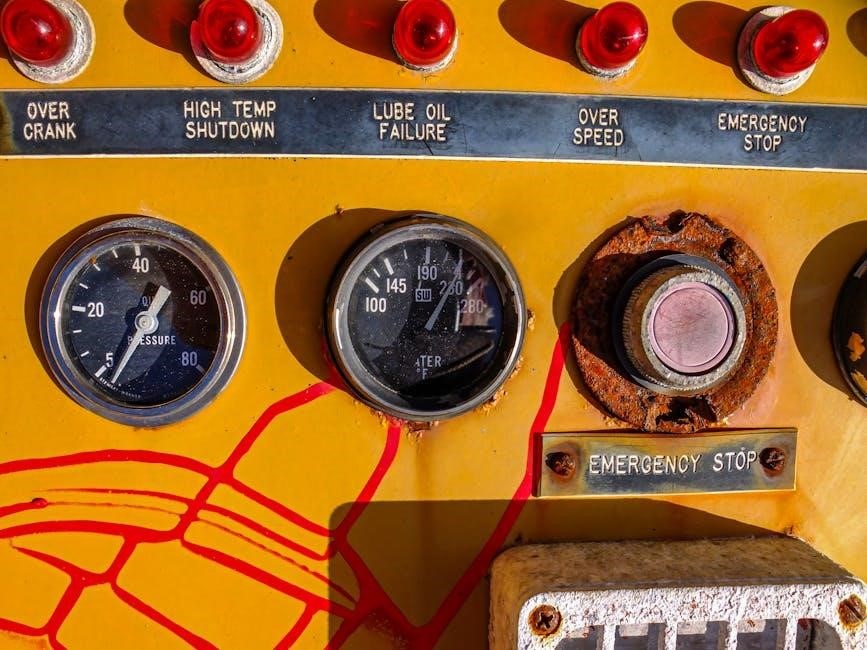atwood carbon monoxide alarm manual
The Atwood Carbon Monoxide Alarm Manual is a comprehensive guide to understanding and using the alarm effectively, including details on features and components, with proper installation procedures outlined.
Purpose of the Manual
The purpose of the Atwood Carbon Monoxide Alarm Manual is to provide users with a clear understanding of the alarm’s operation, installation, and maintenance requirements. The manual is designed to be a comprehensive guide, covering all aspects of the alarm’s use and function. It is intended to help users understand how to properly install, operate, and maintain the alarm, as well as how to troubleshoot any issues that may arise. By following the instructions and guidelines outlined in the manual, users can ensure that their Atwood Carbon Monoxide Alarm is functioning correctly and providing effective protection against the dangers of carbon monoxide poisoning. The manual is an essential resource for anyone who owns or uses an Atwood Carbon Monoxide Alarm, and it is important to read and follow the instructions carefully to ensure safe and effective use. The manual is a valuable tool for users.

Understanding the Atwood Carbon Monoxide Alarm
The Atwood alarm detects carbon monoxide levels in the air with electronic sensors and alerts users to potential dangers with audible warnings and visual displays always.
Features and Components
The Atwood Carbon Monoxide Alarm features a range of components designed to provide accurate and reliable detection of carbon monoxide levels in the air. These components include electronic sensors, a microprocessor, and an alarm system. The alarm system is designed to alert users to potential dangers with audible warnings and visual displays. The electronic sensors are highly sensitive and can detect even low levels of carbon monoxide, providing users with early warning of potential hazards. The microprocessor is responsible for processing data from the sensors and triggering the alarm system when necessary. The alarm system is designed to be loud and clear, ensuring that users are alerted to potential dangers even in noisy environments. Overall, the features and components of the Atwood Carbon Monoxide Alarm work together to provide a reliable and effective warning system. The alarm is also designed to be easy to use and install.
Types of Atwood Carbon Monoxide Alarms
There are several types of Atwood Carbon Monoxide Alarms available, each designed to meet specific needs and applications. These include battery-powered alarms, hardwired alarms, and plug-in alarms. Some models also feature additional sensors for detecting other gases, such as propane or natural gas; Other types of Atwood Carbon Monoxide Alarms include those designed for use in recreational vehicles, such as RVs and trailers. These alarms are typically compact and lightweight, making them easy to install and use in small spaces. Additionally, some Atwood Carbon Monoxide Alarms are designed for use in commercial or industrial settings, where they can be integrated into larger safety systems. Overall, the range of Atwood Carbon Monoxide Alarms available means that users can choose the model that best meets their specific needs and requirements. The alarms are designed to be reliable and effective.

Installation and Maintenance
Proper installation and maintenance are crucial for Atwood Carbon Monoxide Alarms to function correctly and ensure safety always.
Proper Installation
To ensure the Atwood Carbon Monoxide Alarm functions correctly, proper installation is essential. The alarm should be installed on a wall or ceiling, at least 5 feet away from fuel-burning appliances. It is also important to avoid installing the alarm near windows, doors, or vents, as this can affect its ability to detect carbon monoxide. The alarm should be installed by a qualified technician, and the manufacturer’s instructions should be followed carefully. Additionally, the alarm should be tested after installation to ensure it is working properly. Regular testing and maintenance can help ensure the alarm continues to function correctly over time. By following the manufacturer’s instructions and taking the necessary precautions, homeowners can help ensure their Atwood Carbon Monoxide Alarm is installed and functioning properly, providing them with peace of mind and protection from the dangers of carbon monoxide poisoning. The installation process is critical to the alarm’s effectiveness.
Regular Maintenance
Regular maintenance is crucial to ensure the Atwood Carbon Monoxide Alarm continues to function correctly. The alarm should be tested monthly by pressing the test button to verify it is working properly. Additionally, the alarm’s batteries should be replaced annually, or as indicated by the manufacturer. It is also important to clean the alarm regularly to prevent dust and debris from accumulating and interfering with its operation. The alarm’s sensor should be replaced every 5-7 years, or as recommended by the manufacturer. By performing these regular maintenance tasks, homeowners can help ensure their Atwood Carbon Monoxide Alarm remains effective and continues to provide protection from the dangers of carbon monoxide poisoning. The manufacturer’s instructions should be consulted for specific maintenance recommendations. Regular maintenance can help prevent false alarms and ensure the alarm functions correctly when needed. This helps to provide peace of mind and protection.

Using the Atwood Carbon Monoxide Alarm
Understanding the alarm’s operation and features is essential for effective use and safety always matters with proper installation.
Operating Instructions
To operate the Atwood Carbon Monoxide Alarm, first ensure it is properly installed and powered on. The alarm will automatically begin monitoring for carbon monoxide levels in the air. The user manual provides detailed instructions on how to test the alarm and perform routine checks. It is essential to follow these instructions carefully to ensure the alarm functions correctly. The alarm’s control panel features a series of buttons and lights that indicate its status and any detected carbon monoxide levels. By following the operating instructions outlined in the manual, users can ensure their safety and the effective operation of the alarm. The manual also includes troubleshooting guides to help resolve any issues that may arise during operation. Proper use of the alarm requires attention to these instructions and regular maintenance to guarantee optimal performance and safety. Regular testing is also recommended to ensure the alarm is functioning as expected.
Troubleshooting
The Atwood Carbon Monoxide Alarm manual provides a comprehensive troubleshooting guide to help users resolve common issues. This section outlines steps to take when the alarm is not functioning correctly, including checking power sources and ensuring proper installation. The manual also lists error codes and their corresponding solutions, allowing users to quickly identify and fix problems. Additionally, the troubleshooting guide covers issues related to false alarms and sensor malfunctions. By following these steps, users can quickly resolve issues and ensure the alarm is working correctly. The manual’s troubleshooting section is designed to be easy to follow, with clear instructions and diagrams to help users navigate the process. This section is an essential resource for users who need to troubleshoot their Atwood Carbon Monoxide Alarm, and it helps to ensure the alarm continues to provide reliable protection against carbon monoxide. Regular reference to this section can help prevent issues.

Important Safety Information
Safety precautions and warnings are outlined in the manual to ensure user safety and proper alarm function, with critical information provided.
Carbon Monoxide Hazards
Carbon monoxide is a colorless, odorless, and tasteless gas that can be deadly in high concentrations. The Atwood Carbon Monoxide Alarm Manual provides critical information on the hazards of carbon monoxide, including its sources and symptoms of poisoning. According to the manual, carbon monoxide can be generated by faulty fuel-burning appliances, vehicles, and other equipment. The manual also outlines the importance of proper ventilation and maintenance to prevent carbon monoxide buildup. Additionally, it provides guidance on what to do in case of a carbon monoxide alarm, including evacuating the area and seeking medical attention if necessary. By understanding the hazards of carbon monoxide, users can take steps to protect themselves and their loved ones from this silent killer. The manual is an essential resource for anyone who wants to stay safe from carbon monoxide poisoning. It is a valuable guide for users of the Atwood Carbon Monoxide Alarm.
Limitations of the Alarm
The Atwood Carbon Monoxide Alarm has certain limitations that users should be aware of. According to the manual, the alarm is designed to detect only carbon monoxide and will not sense smoke, fire, or other poisonous gases. The alarm’s sensitivity and accuracy can be affected by various factors, including temperature, humidity, and interference from other devices. The manual also notes that the alarm is not a substitute for proper ventilation and maintenance of fuel-burning appliances. Users should not rely solely on the alarm for protection, but rather use it as part of a comprehensive safety plan. By understanding the limitations of the alarm, users can use it effectively and stay safe from carbon monoxide poisoning; The manual provides important information on the alarm’s limitations and how to use it properly. This information is crucial for users to ensure their safety and the safety of others.
